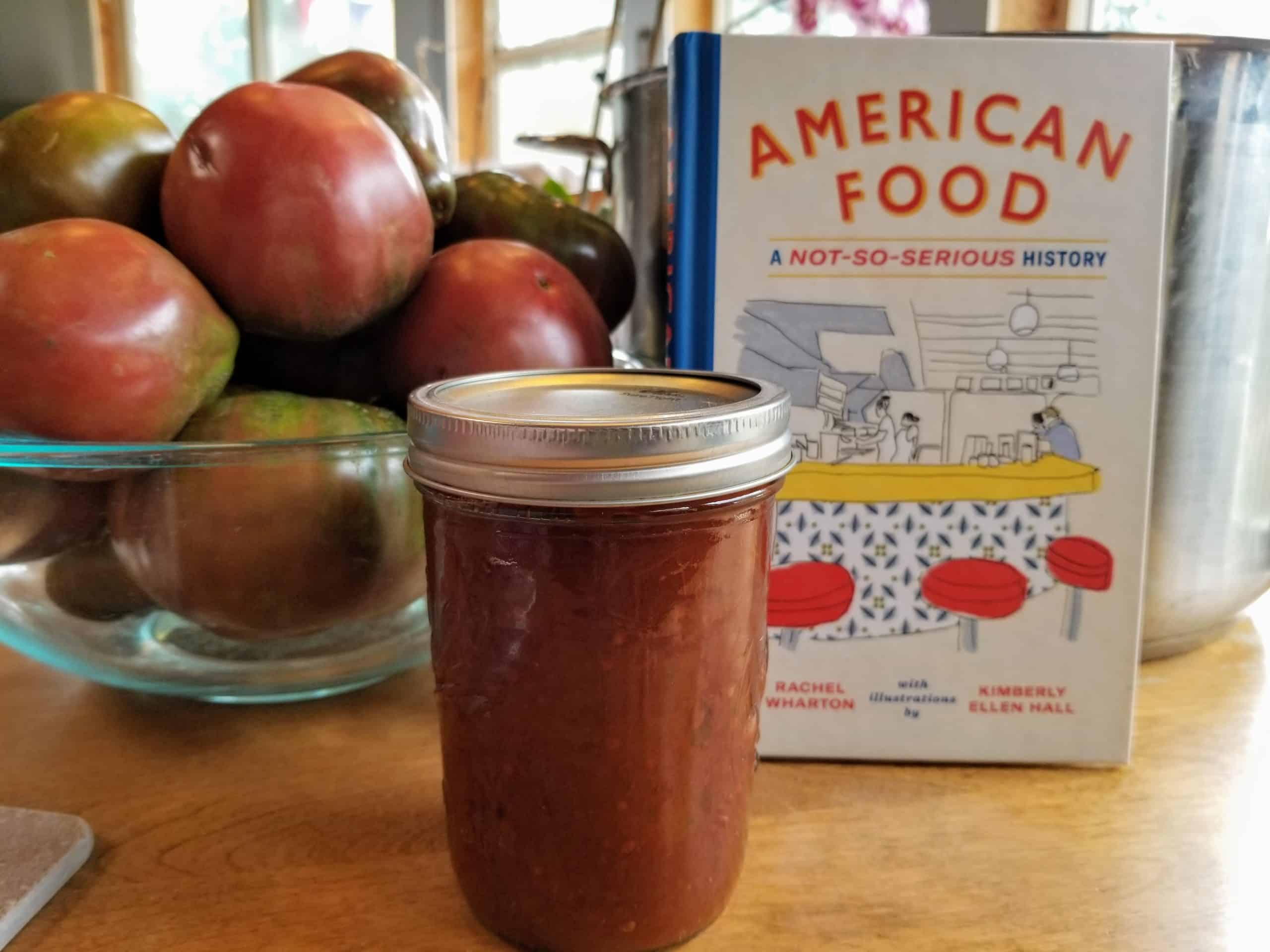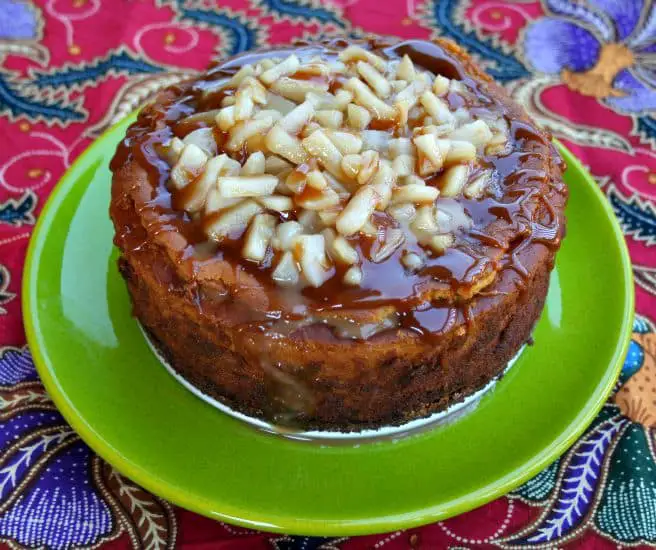American Food by Rachel Wharton – Review and a Recipe for Homemade Ketchup

Ketchup is apparently a quintessential American Food. How do I know this? I learned it from the new book, American Food: A Not So Serious History by Rachel Wharton. I received the book at no charge as part of the Abrams Dinner Party. Read on to learn about the book and see how to make homemade ketchup.
This year was an odd one weather wise – we had three inches of snow in September. We generally get frost sometime in this ninth month but usually not snow. The hubby rushed to get the tomatoes in so they could ripen in the basement. In all the years we have been here we have never had the full tomato harvest ripen on the vine. He brings them and they slowly turn red and I’ll be making tomato sauce, tomato soup, barbecue sauce, tomato paste and homemade ketchup over the next few months.
Right now there are 22 large boxes full of tomatoes. He goes through them every other day and brings me up the ones that have turned red and I use them as I need. I have made one batch of pizza sauce and one batch of ketchup already this year. He loves his ketchup and I like to have about 24 pints on hand each year for him.
All Amazon purchase links are affiliate links which means if you make a purchase I receive a small commission (at no additional cost to you)
About American Food: A Not So Serious History
A clever and whimsical illustrated history of 26 iconic American foods, from Ambrosia to Zucchini Bread
This captivating and surprising tour of America’s culinary canon celebrates the variety, charm, and occasionally dubious lore of the foods we love to eat, as well as the under-sung heroes who made them. Every chapter, organized from A to Z, delves into the history of a classic dish or ingredient, most so common we take them for granted. These distinctly American foods, from Blueberries and Fortune Cookies to Pepperoni, Hot Wings, Shrimp and Grits, Queso, and yes, even Xanthan Gum, have rich and complex back stories that are often hidden in plain sight, lost to urban myth and misinformation. American Food: A Not-So-Serious History digs deep to tell the compelling tales of some of our most ordinary foods and what they say about who we are—and who, perhaps, we are becoming.
About the Author:
Rachel Wharton is a James Beard Award-winning food writer. Wharton is the author of Edible Brooklyn: The Cookbook and co-author of Korean Home Cooking and F*ck, That’s Delicious with Action Bronson. She lives in New York. Kimberly Ellen Hall is an award-winning artist and art professor with a thriving illustration, print, and pattern studio, Nottene. She lives in Philadelphia.
Note: This post may contain affiliate links, which means if you buy from my link I might make a small commission. This does not affect the price you pay. See the full affiliate disclosure here.
My Opinion:
This is a fun kind of foodie book. The author takes a look at different foods/drinks/sauces that are all American in their origins. One for each letter of the alphabet starting with Ambrosia – that glorious pot luck “salad” that, at least for me, is all about the canned mandarin oranges and marshmallows – and ending with zucchini bread – the safe harbor for every person in squash season. I don’t know about you but I’ve made my fair share.
In between the reader will enjoy learning about different quintessentially American foods like donuts. Mmmm, donuts. Fried dough was nothing new but putting a hole in it – apparently revolutionary. No pun intended. Or my favorite chapter, being a child of Philadelphia – the hoagie! Of course this Italian Sandwich as the chapter is entitled has many other names depending upon where in the country you abide (sub, grinder, hero) but even though I have moved into sub country it will always be a hoagie to me.
The history of each food – did you know that the fortune cookies were invented in San Francisco in 1856? You do now and it’s thanks to me reading through this book. Just think of all of the other fun tidbits you will pick up and what a wonderful gift this book would make for someone who loves food.
There are also some fun recipes included in the book. There is one for Vinegar Pie that has the husband very intrigued and I have promised him that I will make it for him. He loves vinegar and he loves pie so how could he not love a vinegar pie?
The book reads very easily and it is very entertaining. I truly enjoyed it.
Rating:
5
This base recipe is taken from the Ball Complete Book of Home Preserving. I have adapted it a bit to suit our tastes. I usually end up make a huge batch with whatever has come up from the basement and just adjusting ingredient measurements to taste.
Homemade Ketchup
7 pints
3 TBS celery seeds
4 tsp whole cloves
2 4″ cinnamon sticks broken in pieces
1 1/2 tsp whole allspice
3 cups cider vinegar
24 lbs tomatoes cored and quartered
3 cups chopped onions
1 tsp cayenne pepper
1 1/2 cups brown sugar
1/4 cup pickling or canning salt
Tie the celery seeds, cloves, cinnamon sticks and allspice in a square of cheesecloth making a bag or use a cheesecloth bag.
In a stainless steel saucepan, combine vinegar and spice bag. Bring to a boil over high heat. Remove from heat and let stand for 25 minutes. Discard spice bag. (I just toss the spices in the vinegar and let it cook. I strain them all out when necessary with a fine strainer. I’ve never had a problem.)
Meanwhile, in a large stainless steel stockpot combine tomatoes, onions and cayenne. Bring to a boil over high heat, stirring frequently. Reduce heat and boil gently for 20 minutes. Add infused vinegar (this is where I strain) and boil gently until vegetables are soft and mixture begins to thicken, about 30 minutes (I have found it takes a bit longer if you have juicy tomatoes. Like several hours)
Working in batches, transfer mixture to a sieve placed over a glass or stainless steel bowl and press with the back of a spoon to extract all the liquid. Or you can use a food mill. Discard solids.
Ketchup Hack: I just put my immersion blender in there and let it rip. If you don’t mind seeds it’s faster and it thickens more quickly. Plus there are a lot of nutrients in the skin that you lose if you mill it all out.
Return liquid to saucepan (with my method it never left.) Add sugar and salt. Bring to a boil over medium heat, stirring occasionally. Reduce heat and boil gently, stirring frequently, until volume is reduced by half and mixture is almost the consistency of commercial ketchup, about 45 minutes. (Again, much longer depending on the juiciness of your tomatoes.)
Meanwhile prepare canner, jars and lids.
Ladle hot ketchup into hot jars, leaving 1/2″ headspace. Remove air bubbles and adjust headspace if necessary by adding hot ketchup. Wipe rim. Center lid on jar. Screw band down until resistance is met, then increase to fingertip tight. Place jars in canner, ensuring they are completely covered with water. Bring to a boil and process for 15 minutes. (20 minutes for over 3,000 ft) Remove canner lid.
Wait 5 minutes, then remove jars, cool and store.
How Was the Homemade Ketchup?
Homemade ketchup is so much better than store bought. It is far less sweet and more tomato-y. You also have more control over the taste as you can adjust the spices if you choose i.e.: add more cayenne or more sugar if you want. The hubby likes his ketchup less sweet so I don’t add any more sugar than is needed and I use brown sugar which adds a little something extra.
He loves it on his farm fresh eggs in the morning or combined with my homemade garlic dill relish on a hamburger. It tastes great on a hot dog on a pretzel bun or a floury bap!
Comments? Questions? Leave them HERE












